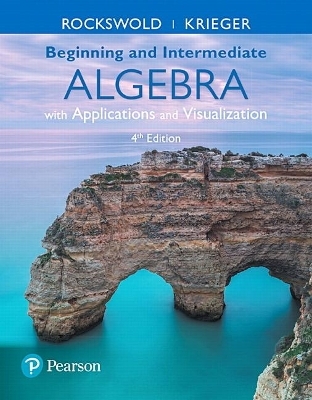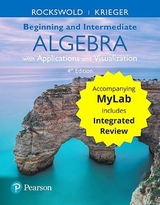
Beginning and Intermediate Algebra with Applications & Visualization
Pearson (Verlag)
978-0-13-447430-4 (ISBN)
- Titel erscheint in neuer Auflage
- Artikel merken
The Rockswold/Krieger algebra series fosters conceptual understanding by developing concepts in context through the use of applications, multiple representations, and visualization. By seeing the concept in context before being given the the mathematical abstraction, students make math part of their own experiences instead of just memorizing techniques. The authors believe this approach deepens conceptual understanding and better prepares students for future math courses and life. The new edition continues to bring concepts to life with even more opportunities for students to visualize the math in real-world contexts-–and so, learn key critical-thinking and problem-solving skills-–with new features in the text and MyLab™ Math.
Also Available with MyLab Math.
MyLab™ Math is an online homework, tutorial, and assessment program designed to work with this text to engage students and improve results. Within its structured environment, students practice what they learn, test their understanding, and pursue a personalized study plan that helps them absorb course material and understand difficult concepts. The 4th Edition continues to help students develop conceptual understanding and bring key concepts to life with content and assignments that reflect the authors’ approach, including new Section Introduction videos and See the Concept videos with assessment. New Skill Builder assignments offer adaptive practice to build students’ foundational skills, and new workspace assignments allow students to show their mathematical reasoning as they progress step-by-step, with specific feedback at each step in the problem-solving process that adjusts to their path.
Note: You are purchasing a standalone product; MyLab™ Math does not come packaged with this content. Students, if interested in purchasing this title with MyLab Math, ask your instructor for the correct package ISBN and Course ID. Instructors, contact your Pearson representative for more information.
0134768728 / 9780134768724 Beginning and Intermediate Algebra with Applications & Visualization Plus MyLab Math -- Title-Specific Access Card Package, 4/e
Package consists of:
0134474309 / 9780134474304 Beginning and Intermediate Algebra with Applications & Visualization
0134753526 / 9780134753522 MyLab Math with Pearson eText -- Standalone Access Card -- for Beginning and Intermediate Algebra with Applications & Visualization
Gary Rockswold has been a professor and teacher of mathematics, computer science, astronomy, and physical science for over 35 years. Not only has he taught at the undergraduate and graduate college levels, but he has also taught middle school, high school, vocational school, and adult education. He received his BA degree with majors in mathematics and physics from St. Olaf College and his PhD in applied mathematics from Iowa State University. He has been a principal investigator at the Minnesota Supercomputer Institute, publishing research articles in numerical analysis and parallel processing. He is currently an emeritus professor of mathematics at Minnesota State University–Mankato. He is an author for Pearson Education and has numerous textbooks at the developmental and precalculus levels. Making mathematics accessible to students and professing the power of mathematics are special passions for Gary. He frequently gives keynote and invited addresses at regional, national, and international math conferences. In his spare time he enjoys sailing, doing yoga, hiking, and spending time with his family. Terry Krieger has taught mathematics for over 20 years at the middle school, high school, vocational, community college, and university levels. His undergraduate degree in secondary education is from Bemidji State University in Minnesota, where he graduated summa cum laude. He received his MA in mathematics from Minnesota State University–Mankato. In addition to his teaching experience in the United States, Terry has taught mathematics in Tasmania, Australia, and in a rural school in Swaziland, Africa, where he served as a Peace Corps volunteer. Terry has been involved with various aspects of mathematics textbook publication throughout his career. In his free time, Terry enjoys spending time with his wife and two boys, physical fitness, wilderness camping, and trout fishing.
Table of Contents
Introduction to Algebra
1.1 Numbers, Variables, and Expressions
1.2 Fractions
1.3 Exponents and Order of Operations
1.4 Real Numbers and the Number Line
1.5 Addition and Subtraction of Real Numbers
1.6 Multiplication and Division of Real Numbers
1.7 Properties of Real Numbers
1.8 Simplifying and Writing Algebraic Expressions
Linear Equations and Inequalities
2.1 Introduction to Equations
2.2 Linear Equations
2.3 Introduction to Problem Solving
2.4 Formulas
2.5 Unit Analysis
2.6 Linear Inequalities
Graphing Equations
3.1 Introduction to Graphing
3.2 Equations in Two Variables
3.3 Intercepts; Horizontal and Vertical Lines
3.4 Slope and Rates of Change
3.5 Slope-Intercept Form
3.6 Point-Slope Form
3.7 Introduction to Modeling
Systems of Linear Equations in Two Variables
4.1 Solving Systems of Linear Equations Graphically and Numerically
4.2 Solving Systems of Linear Equations by Substitution
4.3 Solving Systems of Linear Equations by Elimination
4.4 Systems of Linear Inequalities
Polynomials and Exponents
5.1 Rules for Exponents
5.2 Addition and Subtraction of Polynomials
5.3 Multiplication of Polynomials
5.4 Special Products
5.5 Integer Exponents and the Quotient Rule
5.6 Division of Polynomials
Factoring Polynomials and Solving Equations
6.1 Introduction to Factoring
6.2 Factoring Trinomials I (x2 + bx + c)
6.3 Factoring Trinomials II (ax2 + bx + c)
6.4 Special Types of Factoring
6.5 Summary of Factoring
6.6 Solving Equations by Factoring I (Quadratics)
6.7 Solving Equations by Factoring II (Higher Degree)
Rational Expressions
7.1 Introduction to Rational Expressions
7.2 Multiplication and Division of Rational Expressions
7.3 Addition and Subtraction with Like Denominators
7.4 Addition and Subtraction with Unlike Denominators
7.5 Complex Fractions
7.6 Rational Equations and Formulas
7.7 Proportions and Variation
Introduction to Functions
8.1 Functions and Their Representations
8.2 Linear Functions
8.3 Compound Inequalities and Piecewise-Defined Functions
8.4 Other Functions and Their Properties
8.5 Absolute Value Equations and Inequalities
Systems of Linear Equations
9.1 Systems of Linear Equations in Three Variables
9.2 Matrix Solutions of Linear Systems
9.3 Determinants
Radical Expressions and Functions
10.1 Radical Expressions and Functions
10.2 Rational Exponents
10.3 Simplifying Radical Expressions
10.4 Operations on Radical Expressions
10.5 More Radical Functions
10.6 Equations Involving Radical Expressions
10.7 Complex Numbers
Quadratic Functions and Equations
11.1 Quadratic Functions and Their Graphs
11.2 Transformations and Translations of Parabolas
11.3 Quadratic Equations
11.4 The Quadratic Formula
11.5 Quadratic Inequalities
11.6 Equations in Quadratic Form
Exponential and Logarithmic Functions
12.1 Composite and Inverse Functions
12.2 Exponential Functions
12.3 Logarithmic Functions
12.4 Properties of Logarithms
12.5 Exponential and Logarithmic Equations
Conic Sections
13.1 Parabolas and Circles
13.2 Ellipses and Hyperbolas
13.3 Nonlinear Systems of Equations and Inequalities
Sequences and Series
14.1 Sequences
14.2 Arithmetic and Geometric Sequences
14.3 Series
14.4 The Binomial Theorem
Appendix A. Using the Graphing Calculator Appendix B. Sets Appendix C. Linear Programming Appendix D. Synthetic Division
| Erscheinungsdatum | 01.03.2017 |
|---|---|
| Sprache | englisch |
| Maße | 218 x 277 mm |
| Gewicht | 2177 g |
| Themenwelt | Mathematik / Informatik ► Mathematik ► Algebra |
| ISBN-10 | 0-13-447430-9 / 0134474309 |
| ISBN-13 | 978-0-13-447430-4 / 9780134474304 |
| Zustand | Neuware |
| Informationen gemäß Produktsicherheitsverordnung (GPSR) | |
| Haben Sie eine Frage zum Produkt? |
aus dem Bereich



